Optical imaging of the peri-tumoral inflammatory response in breast cancer
- PMID: 19906309
- PMCID: PMC2780997
- DOI: 10.1186/1479-5876-7-94
Optical imaging of the peri-tumoral inflammatory response in breast cancer
Abstract
Purpose: Peri-tumoral inflammation is a common tumor response that plays a central role in tumor invasion and metastasis, and inflammatory cell recruitment is essential to this process. The purpose of this study was to determine whether injected fluorescently-labeled monocytes accumulate within murine breast tumors and are visible with optical imaging.
Materials and methods: Murine monocytes were labeled with the fluorescent dye DiD and subsequently injected intravenously into 6 transgenic MMTV-PymT tumor-bearing mice and 6 FVB/n control mice without tumors. Optical imaging (OI) was performed before and after cell injection. Ratios of post-injection to pre-injection fluorescent signal intensity of the tumors (MMTV-PymT mice) and mammary tissue (FVB/n controls) were calculated and statistically compared.
Results: MMTV-PymT breast tumors had an average post/pre signal intensity ratio of 1.8+/- 0.2 (range 1.1-2.7). Control mammary tissue had an average post/pre signal intensity ratio of 1.1 +/- 0.1 (range, 0.4 to 1.4). The p-value for the difference between the ratios was less than 0.05. Confocal fluorescence microscopy confirmed the presence of DiD-labeled cells within the breast tumors.
Conclusion: Murine monocytes accumulate at the site of breast cancer development in this transgenic model, providing evidence that peri-tumoral inflammatory cell recruitment can be evaluated non-invasively using optical imaging.
Figures
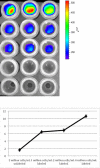
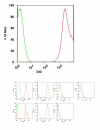
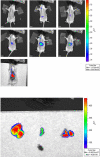
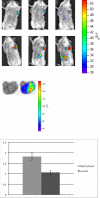
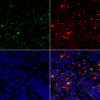
References
Publication types
MeSH terms
Substances
Grants and funding
LinkOut - more resources
Full Text Sources
Medical

